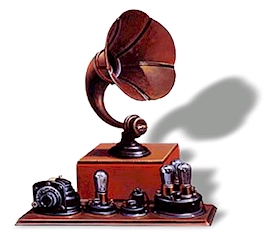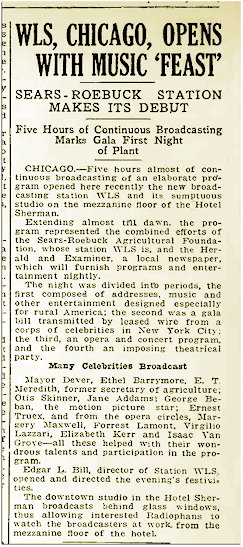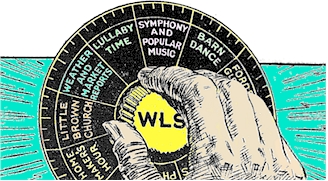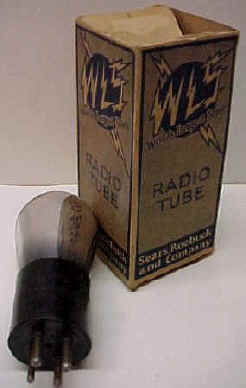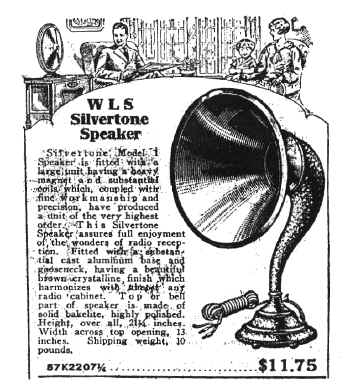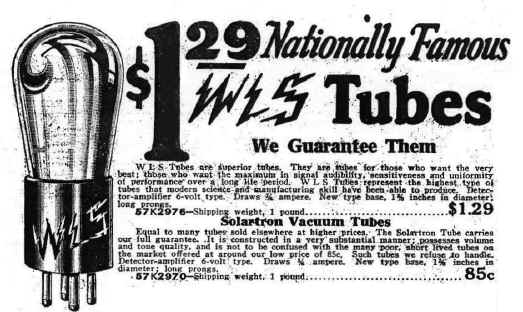|
|
||||||
|
The early 1920's. Birth of commercial radio as we know it today. KDKA in Pittsburg is recognized as being the first broadcast outlet, having given the election returns of the Harding-Cox presidential race in 1920. 1921 brought WJZ New York to the air with music and entertainment. Primitive radio sets were the norm in the early days, ranging from crystal "cat whisker" receivers, often fashioned out of oatmeal boxes. It got its name from its most important component, known as a crystal detector, originally made with a piece of crystalline mineral such as galena. Crude homemade single and multiple tube sets, both utilizing headphones were also being pioneered in the early days of radio broadcasting. By mid-decade, the tuned radio frequency receiver represented a major improvement in performance over what had been available before, later to be replaced by the superheterodyne receiver.
While transmitting and studio equipment was being completed for the new station, Sears was anxious to get on the air. For three weeks, the foundation bought airtime for a noontime farm program beginning on March 21, 1924, with its first assigned call letters WBBX, from the studios of WMAQ Radio.
On April 9, 1924 Sears signed on 500 watt WES (for World's Economy Store) from it's own studios in Chicago, Illinois. The small studio was located next to the Agricultural Foundation offices on the 11th floor of the 14 story Sears-Roebuck tower. The company's drafting room served as a control room, sending the signal to the transmitter site, located in Crete. The initial night of testing featured singer Grace Wilson and the musical comedy team of Big Ford and Little Glenn. Ford Rush was actually the first employee of the new Sears station, and was also it's first announcer. Glenn Rowell soon became Studio Director and also headed up the station's music department. Over the next two evenings (April 10 & 11) Sears aired more test programs. The Sears switchboards reportedly "lit up like Christmas trees" with listeners checking in after hearing the broadcasts.
|
||||||
|
|
||||||
|
(L-R) Sam
Guard and Edgar Bill apply the finishing touches,
hours before the inaugural WLS broadcast. |
||||||
|
After several days of experimental transmissions, the station officially went on-the-air on April 12th. On the evening of formal dedication, Sears changed the calls to WLS Radio. The call letters stood for World's Largest Store, a name the giant retailer and catalogue merchant had gained from their West Side Headquarters on Homan Avenue.
|
||||||
|
|
On that first
official night, numerous officials and luminaries attended a
gala banquet from it's new main studio site on the mezzanine
floor in the Sherman House Hotel. Many executives from
Sears were on hand for the big night including Edgar Bill,
director and program manager of the new station and Samuel R.
Guard, director of the Sears Roebuck Agricultural Foundation.
Shortly after 6:00 pm, Edgar Bill stepped to the microphone and exclaimed "Here ye, here ye, here ye! WLS, the Sears-Roebuck station is on the air!" With those words, station WLS was off and running! Ford and Glenn appeared on the inaugural night as well as Grace Wilson, who sang "At The End Of The Sunset Trail" in addition to a new song by station organist Ralph Waldo Emerson. As the night wore on, renowned dramatic actress Ethel Barrymore was introduced to say a few words on the broadcast. However, upon seeing the new-fangled microphone, she froze up and exclaimed "Turn that damned thing off!" Movie cowboy hero William S. Hart recited a powerful rendition of "Invictus" with his eyes shut, fists clenched and perspiration pouring down his face! Notable speakers on hand included Chicago Mayor William E. Dever, Jane Addams of the Hull House; H.W. Mumford of the Illinois College of Agriculture and E.T. Meredith, former US Secretary of Agriculture among others. Through a special hookup with a station in New York, special opening addresses were given by Gloria Swanson, Amelia Bingham, Arthur Brisbane, H.B. Warner and William Faversham. According to Edgar Bill, "It was a grand opening, never to be forgotten by those in attendance." |
|||||
|
|
||||||
|
|
Originally, the Sears station was licensed to south suburban Crete. This was the dawning era of radio and Sears knew they could get in on the ground floor by not only selling radios, but providing programming and farm service as well. As stated in the 1925 Sears Catalogue, "WLS was conceived in your interests, is operated in your behalf and is dedicated to your service. It is your station." Broadcasting several hours a day, the station's slogan becomes "Bringing The World To The Farm." According to accounts, in little more than four years, WLS went from being an obscure signal to a Midwestern powerhouse. It was even rumored to be heard as far away as New Zealand! The station aired speeches from President Calvin Coolidge, Ralph Stockton's sermons, the comedy of Pie Plant Pete and the wit of Will Rogers. WLS hosted a 1925 Military Tournament as well as Chicago's reception of Colonel Charles Lindbergh
While the main focus was farm and civic programming, several popular-music, comedies and radio serials could be heard as well. Nearly 60 different bands called WLS home, while over 130 musical acts aired on the station for free. On April 19th, 1924 the station aired the first National Barn Dance program, a four-hour cavalcade of music, comedy and down-home entertainment. The program went on to become one of the most popular and longest running country-and-western shows in history, second only to The Grand Old Opry. By 1932, the National Barn Dance program would be cut to two hours and broadcast live, originating from the Eighth Street Theater in the South Loop.
|
|||||
|
|
||||||
 |
|
|||||
|
|
|
|||||
|
|
||||||
|
|
||||||
|
|
||||||
|
Another popular show during the station's
early years was "WLS Unlimited." The show would
begin with a whistle blown by The "Solemn Old
Judge," played by George D. Hay. The Indiana born Hay who
moved with his family to Chicago when he was a child was
hardly solemn and certainly not old - at age 29! Ford and
Glenn were also featured on the program which took listeners
on a transcontinental trip across the country. "WLS -
Chi-caw-go! The first stop will be Clinton Iowa," Hay
would proclaim! The Solemn Old Judge had another cohort, a
double yellow-headed Mexican parrot named "Static,"
who learned to speak English. Static would assist Hay in
calling out the stops on the WLS Unlimited. The parrot was
given the run of the station and could often be heard
squawking in the background during other WLS programs.
In September 1924, Hay was awarded the title of "World's
Best Radio Announcer" by Radio Digest Illustrated. In
addition to the accolades, he also received a 14 carat gold
trophy at a ceremony in New York City. |
||||||
|
In addition to farm
programming, children's shows and "down-home entertainment, the
station also aired vaudeville skits,
one act comedies and even sound poems "...given by professional
readers." WLS was one of the
first radio stations to air Shakespeare plays. In September 1924, the
wife of playwright H.D. Saddler directed "The Merchant Of
Venice" in addition to many other plays. The performances were
pared down to thirty minutes with a brief synopsis of the scenes that
didn't make the broadcast. A group of farm plays written around the
modern farmer and his family were also presented. |
||||||
|
|
||||||
|
|
||||||
|
|
The WLS Showboat - 1925 |
|||||
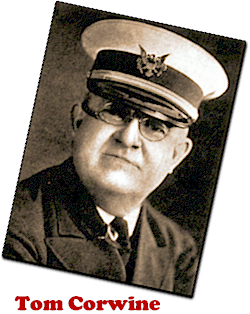 |
||||||
|
Beginning in 1925, The WLS Showboat plied
its way into thousands of homes as it sounded its horn every Friday
evening from the main studio. It was created "through an effort to
bring together a full evening's entertainment of song and dialogue into
a show, so that instead of being a series of separate musical acts, all
would combine into one big show." The idea, featuring Harold
Safford, Tom Corwine, singing cowboy Bradley Kincaid and organist Ralph
Waldo Emerson (who provided the calliope music) as well as many
musicians and performers. Such a popular show, the WLS Showboat was
taken on the road to play in front of live audiences.
|
||||||
|
On March 19,
1927, WLS made history by being the first radio station to
broadcast Beethoven's entire 9th Symphony, which a station
publication at the time called "...the only complete
performance of the work ever given on the air in the
U.S.".
After a frequency shuffle in autumn 1928, WLS changed from 3/7 to 5/7 time at 870 kHz. A court order permitted WENR, known as "The Voice of Service in Chicago" to share equal on-air time with WLS. The station, owned by Great Lakes Broadcasting Company (originally opened by E.N. Rauland), signed on in March, 1925.
|
||||||

 WENR tended to broadcast a more urban schedule, with the WENR Studio Orchestra featuring Frank Westphal (who defected from WLS) at the piano, lectures, drama and light comedy. Performers included Jim and Marian Jordan (right), who later became known as Fibber McGee & Molly on WMAQ/NBC. |
||||||
|
|
|
|||||
|
|
||||||
|
Broadcasting mainly from the Civic
Opera House, WENR appealed to a more urban audience. The station, (which
had utilities magnate Samuel Insull as an investor), featured the Edison
Symphony Orchestra and the Home Services Show, sponsored by Peoples Gas
Light & Coke Company. The WENR Studio Orchestra featured Frank
Westphal on piano, who had previously aired on WLS. WENR also aired
minstrel and comedy shows and a strange program starring a singing
canary! With the time-sharing agreement, the two
stations would squabble back and forth for the next 26 years.
WENR was acquired by NBC in 1931 and became, along with WLS, the Chicago
outlets for the Blue Network.
|
||||||

|
|
|||||
|
|
||||||
|
|
||||||
|
The Maple City Four: Pat Petterson, Art Janes, Al Rice, Fritz Meissner. |
One of the more popular acts on WLS and the National Barn Dance were LaPorte Indiana's Maple City Four. The quartet, who joined the station in 1926, mixed barbershop harmonies with wildly popular comedy routines and minstrel sketches. They later went on to appear in movies starring Gene Autry and Roy Rogers. In addition to the Barn Dance audiences, the Maple City Four were also a favorite of Prairie Farmer Magazine owner Burridge Butler, a man who would soon become their new boss.
|
|||||
|
The Maple City Four |
||||||
|
|
||||||
|
||||||

